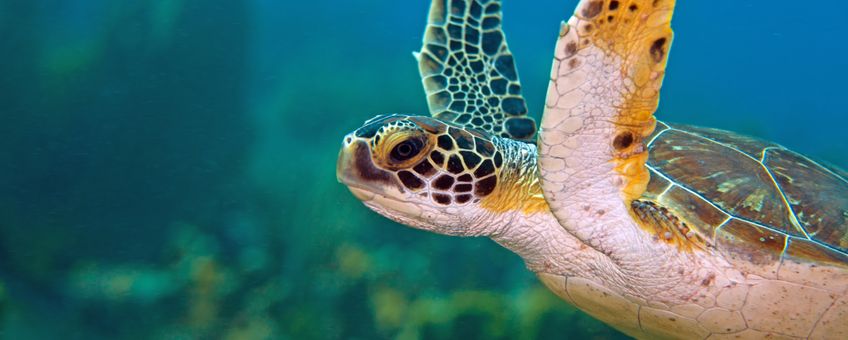
Genetic testing to measure sea turtle conservation success
Dutch Caribbean Nature Alliance (DCNA), Sea Turtle Conservation Bonaire, University of GroningenThese results give researchers insight in the success rates of conservation efforts throughout the entire Caribbean and south Atlantic areas. Understanding how sea turtles move within the Caribbean is crucial for developing holistic conservation plans. Although sea turtles may have hatched from different breeding grounds, known as rookeries, throughout the Caribbean, their migratory journeys lead them to congregate within just a few key foraging areas. A recent study investigated shifts in juvenile population compositions between the years 2006-2007 and 2015-2016 within Lac Bay, Bonaire. By combining this information with rookery recovery rates, researchers can estimate how population shifts are affected by adult female abundance and variation in nesting sizes.

Threats
Sea turtle migration patterns can be affected by a variety of different factors. Ocean currents and temperature changes can influence the early life stages of turtles, leading to changes in the population’s composition. Humans can also directly affect local populations through detrimental acts such as contributing to habitat loss and decreased water quality or through conservation efforts, leading to an increase in juvenile recruitment.
The Caribbean green sea turtle (Chelonia mydas) is a particularly good example of how populations can drastically change over time. Present populations of this species are just one percent of their historical values, prior to human exploitation and deteriorating environmental conditions. Fortunately, recent conservation efforts are leading to a slow recovery in the number of these turtles.
Overall trends
Recent data show green sea turtle populations seem to be on the rise. Scientists have reported increases in nesting trends as high as 14 percent for Florida and around 5 percent within the eastern Caribbean, on Aves Island, Venezuela. Although green sea turtles hatch throughout the Caribbean, there are a few key habitats where juveniles forage. One of these popular foraging grounds is located in Lac Bay, Bonaire.
Genetic markers
Researchers were hoping to gain insight in how these variations in recovery rates of sea turtle populations affected the overall genetic diversity within Lac Bay. Using mitochondrial DNA (mtDNA) from juveniles, researchers can identify the geographical region where each turtle hatched.
Between 2006 and 2016, tissue samples from 332 juvenile green sea turtles were collected, from which a fragment of the mitochondrial DNA was sequenced. Researchers were able to divide the sea turtles as coming from rookeries in four geographical areas: northwestern Caribbean, southwestern Caribbean, eastern Caribbean and southern Atlantic. Overall, there was a significant shift in the genetic make-up over the length of the study, with an overall increase in juvenile recruitment from the northwestern Caribbean (from 12 to 38 percent), and a general decrease in population recruitments from both eastern Caribbean (from 46 to 20 percent) and southern Atlantic (5 to 2 percent).
The results
Overall, researchers were able to show that the genetic make-up of green sea turtles within Lac Bay demonstrated an increase in populations originating from the northwestern Caribbean. Interestingly, overall juvenile green turtle populations did not significantly increase within Lac Bay throughout this study period. The stability of the Lac Bay turtle population could mean that this foraging area is nearing or at carrying capacity. If at carrying capacity, the competition for resources may lead some sea turtles to find other foraging areas. On the other hand, another research group found a positive trend for green turtles within Lac Bay between 2003 and 2018, fluctuating between the lower and upper limits of carrying capacity with a mean abundance of 350 individuals.
It is also important to note that generalizing the differences in nesting trends and recruitment within feeding grounds can be extremely difficult. There are many factors which can contribute to population shifts since hatchling mortality and nest productions can vary significantly from year to year. Furthermore, the average age of foraging turtles within Lac Bay is between six and ten years. Therefore, there is an expected time lag of nearly a decade between changes in nesting successes and population shifts within the bay.
Recent conservation efforts have helped Suriname increase green sea turtle nesting, which could result in an increase in the eastern Caribbean sea turtle population within Lac Bay in the upcoming years. In addition, scientists believe turtles may shift foraging grounds as they develop due to their natal homing capabilities. This could explain why, in Lac Bay, recruitment from southwestern Caribbean was high when studying the entire population, however, when only smaller juveniles were analyzed, recruitment from northwestern and eastern Caribbean was proportionately higher. This shift could represent larger juveniles leaving Lac Bay to return to their birth rookeries.

The future of sea turtles
This study highlights the success of current efforts to protect sea turtle nesting beaches by demonstrating the increase in juveniles originating from areas with successful conservation efforts. This study also demonstrates how genetic testing can be an effective way to monitor trends within populations.
Conservation efforts that protect hatch sites are critical, but only effective for a small portion of a sea turtle’s life cycle. Therefore a more holistic approach needs to be taken to conserve this critical species. Many environmental changes, such as sand temperature, water quality and habitat loss could have a significant impact on these populations as well. Understanding the relationship between environmental factors, sea turtle life cycles and rehabilitation of sea turtle populations will be critical in designing effective management strategies for this species in the future. The researchers are very thankful for the support with collecting data and to conduct conservation activities by Sea Turtle Conservation Bonaire.
More information
Text: Dutch Caribbean Nature Alliance; Sea Turtle Conservation Bonaire; Jurjan van der Zee, University of Groningen
Photos: Brenda Kirby (lead photo: green sea turtle); Marion Haarsma
